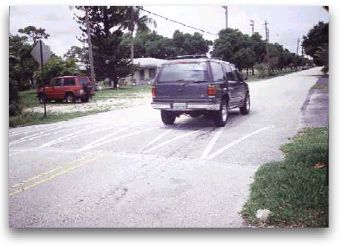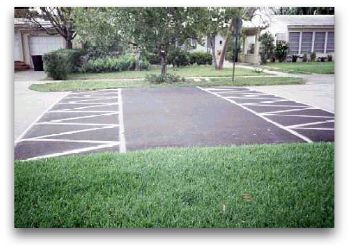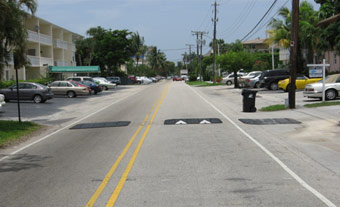 |
|
|
The term speed hump is used to distinguish this device from the speed bumps used in parking lots. The speed hump is safe to use at much higher speeds than a bump thereby minimizing liability. I have experience with two types of speed humps in the UK and USA. Below:
Below:
In my experience the speed hump is effective in reducing vehicle speeds and may reduce traffic volumes a little if there is a high volume of cut through traffic. They are very well accepted by the public to the point that demand greatly exceeds government willingness to install them. The rounded profile humps placed in a series (they're only used in a series to minimize liability) 350-550 feet apart will reduce 85 percentile speeds (the traffic engineer's measure) by 8-10 mph. measured between humps. Average speed will reduce 6-8 mph. I've used rounded profile humps on roads with up to 3,000 vehicles per day. Flat top humps seem to be a better option for higher volume roads as they are less noisy and less objectionable to emergency service operators. A 3 inch high flat top hump is largely psychological in effect with an average speed reduction of 2-5 mph. However a 4 inch high hump will give speed reductions approaching those of a rounded profile hump (provided spacing is similar). I have used flat top speed humps on a road carrying over 7000 vehicles per day. Some people will request that humps not be sited directly in front of their homes but I've received very few complaints about noise. Humps seem to be a good answer to excessive speed. They cost about $1500 each and are surprisingly difficult to construct to the correct profile. They are ugly, particularly when striped to draw attention to them. It is possible to give them a paver block appearance by stamping and painting the asphalt.
Removable rubber speed humps can be purchased but have been more expensive than asphalt.
Speed CushionsIn recent years speed cushions have been developed which overcome some of the emergency services' objections to speed humps, as they allow wide vehicles to straddle the cushion to cross at higher speed. They are best constructed from removable rubber segments. They need to be carefully positioned and dimensioned so as to slow the majority of traffic.
|




